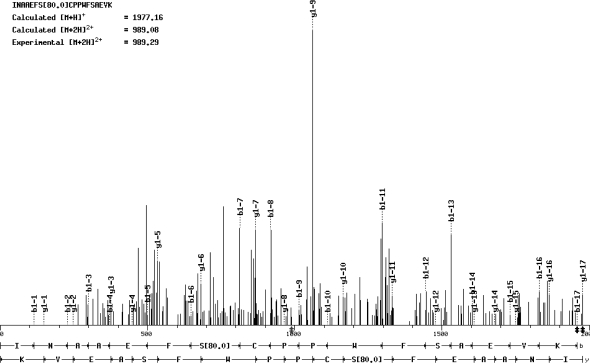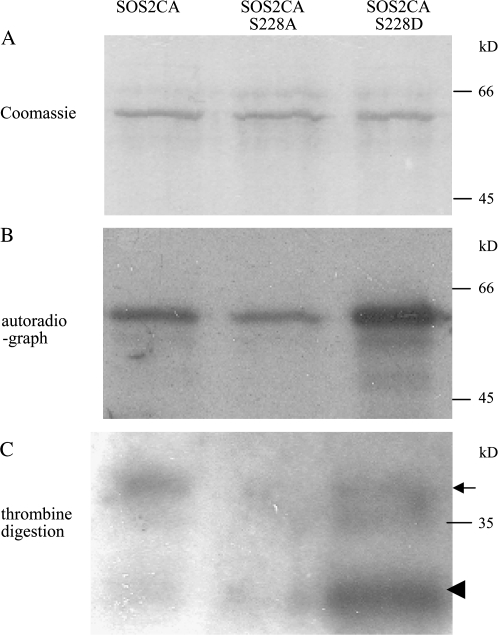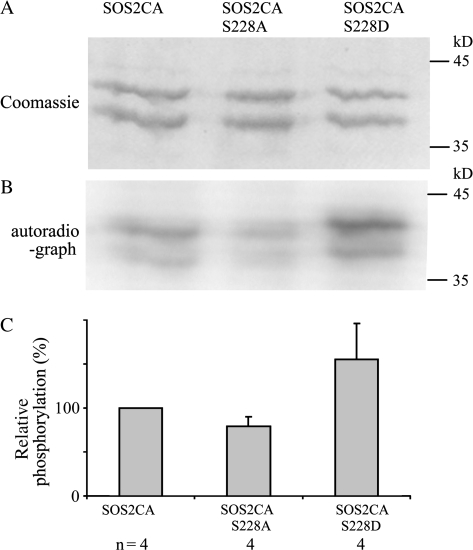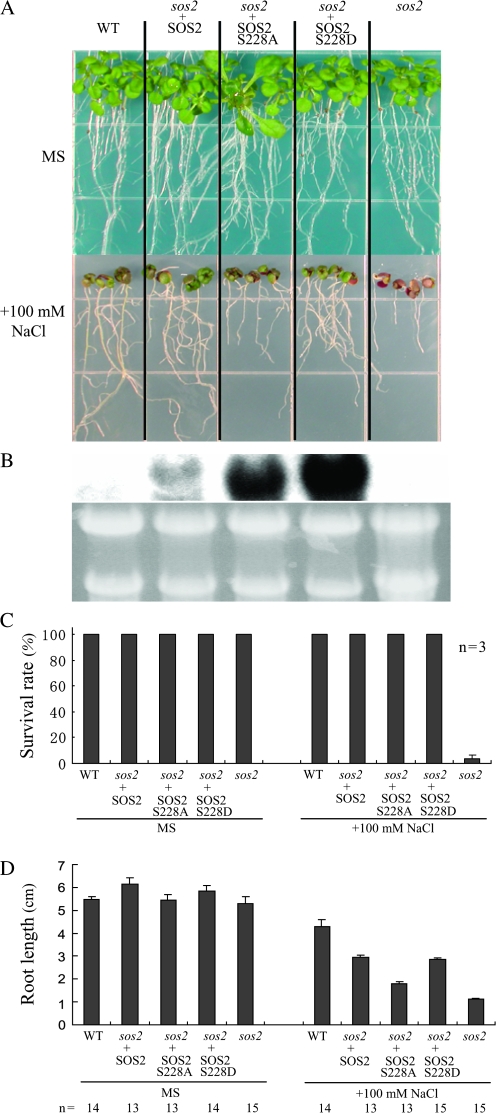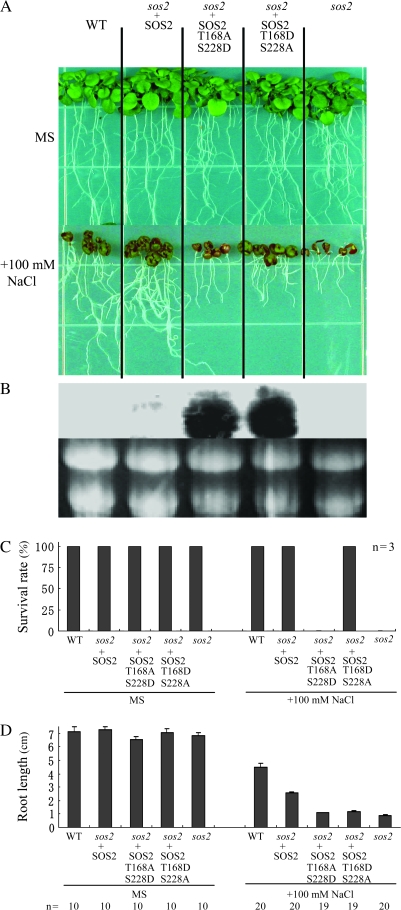Abstract
The protein kinase SOS2 (Salt Overly Sensitive 2) is essential for salt-stress signaling and tolerance in Arabidopsis. SOS2 is known to be activated by calcium-SOS3 and by phosphorylation at its activation loop. SOS2 is autophosphorylated in vitro, but the autophosphorylation site and its role in salt tolerance are not known. In this study, we identified an autophosphorylation site in SOS2 and analyzed its role in the responses of Arabidopsis to salt stress. Mass spectrometry analysis showed that Ser 228 of SOS2 is autophosphorylated. When this site was mutated to Ala, the autophosphorylation rate of SOS2 decreased. The substrate phosphorylation by the mutated SOS2 was also less than that by the wild-type SOS2. In contrast, changing Ser228 to Asp to mimic the autophosphorylation enhanced substrate phosphorylation by SOS2. Complementation tests in a sos2 mutant showed that the S228A but not the S228D mutation partially disrupted the function of SOS2 in salt tolerance. We also show that activation loop phosphorylation at Thr168 and autophosphorylation at Ser228 cannot substitute for each other, suggesting that both are required for salt tolerance. Our results indicate that Ser 228 of SOS2 is autophosphorylated and that this autophosphorylation is important for SOS2 function under salt stress.
Keywords: SOS2, autophosphorylation, salt tolerance, protein kinase, Arabidopsis
INTRODUCTION
Because soil salinity is a serious environmental stress limiting plant productivity, comprehension of cell signaling pathways under salt stress is important. In Arabidopsis thaliana, the SOS (Salt Overly Sensitive) pathway is a major signaling pathway required for salt stress tolerance. The SOS pathway consists of three proteins, SOS1, SOS2, and SOS3. SOS1 is a plasma membrane Na+/H+ antiporter (Shi et al., 2000). SOS2 is a member of the SNF1-related protein kinase 3 (SnRK3) family (Liu et al., 2000; Hrabak et al., 2003). SOS3 is a myristoylated calcium-binding protein (Liu and Zhu, 1998; Ishitani et al., 2000). SOS3 forms a complex with SOS2, activates the substrate phosphorylation activity of SOS2 in a calcium-dependent manner (Halfter et al., 2000; Liu et al., 2000), and also recruits SOS2 to the plasma membrane. The SOS3–SOS2 protein kinase complex phosphorylates SOS1 to stimulate its Na+/H+ antiport activity (Qiu et al., 2002; Quintero et al., 2002). Thus, the SOS pathway regulates Na+ homeostasis under salt stress, and SOS2 is one of the pivotal kinases under salt stress. Loss-of-function mutations in SOS1, SOS2, or SOS3 cause hypersensitivity to NaCl (Zhu et al., 1998). On the other hand, overexpression of SOS1 (Shi et al., 2003) or ectopic expression of an activated form of SOS2 (Guo et al., 2004) increases salt tolerance in transgenic plants.
Because SOS2 protein is not constitutively active in substrate phosphorylation in vitro (Gong et al., 2002), its activation is a key signaling event under salt stress. In SOS2, the catalytic domain is located in the N-terminal region, and the FISL motif is located in the C-terminal regulatory region and serves as an autoinhibitory domain. Removing the FISL motif or the entire C-terminal regulatory region makes SOS2 constitutively active (Guo et al., 2001; Qiu et al., 2002). The FISL motif also interacts with SOS3 (Halfter et al., 2000; Liu et al., 2000), and evidence suggests that the binding of Ca–SOS3 relieves the autoinhibitory function of the FISL motif. Recently, another binding partner of SOS2 has been reported (Quan et al., 2007). SOS3-like calcium-binding protein 8 (SCaBP8, also referred to as Calcineurin B-like10) also interacts with and regulates SOS2 through the FISL motif. SOS3 functions mainly in the root whereas SCaBP8 functions mainly in the shoot (Quan et al., 2007).
Another activation mechanism of SOS2 is phosphorylation in the activation loop. The activation loop is a highly conserved region among various kinases, and many protein kinases are activated by phosphorylation of one or more residues within their activation loop (Hanks and Hunter, 1995; Johnson et al., 1996). In the SnRK3 subfamily, the activation loop is located between the conserved DFG and APE residues in the kinase catalytic domain (Guo et al., 2001). Ser 156, Thr 168, and Tyr 175 residues are completely conserved among all members of this subfamily. When one of these residues was changed to Asp to mimic phosphorylation, the mutant proteins were constitutively active in vitro (Gong et al., 2002). The activation loop mutation and the autoinhibitory domain deletions have a synergistic effect on the kinase activity of SOS2 (Guo et al., 2001; Qiu et al., 2002). Furthermore, transgenic plants expressing the T168D (Thr168 is mutated to Asp) form of SOS2 in both wild-type and sos3 background had improved salt tolerance (Guo et al., 2004).
Besides the mechanisms described above (interaction with SOS3 and phosphorylation in the activation loop), autophosphorylation might regulate SOS2 activity because the GST (glutathione S transferase)-fused constitutively active form of SOS2 shows intramolecular autophosphorylation in vitro (Gong et al., 2002). Several kinases have been reported to regulate its function through intramolecular autophosphorylation (Schulze-Muth et al., 1996; Yang et al., 2005; Jansen et al., 2006). In this study, we analyzed the autophosphorylation of SOS2. We identified an autophosphorylation site and examined the importance of this site using transgenic plants expressing SOS2 with mutations at the site.
RESULTS
Ser228 Is Autophosphorylated In Vitro
A constitutively active form of SOS2 (SOS2CA), in which Thr168 is changed to Asp and the C-terminal 139 amino acids are deleted, shows strong autophosphorylation activity in vitro (Gong et al., 2002). To determine the autophosphorylation site(s), phosphorylated GST-fused SOS2CA was analyzed by mass spectrometry. Recombinant GST–SOS2CA was purified from E. coli and phosphorylated by incubating with non-radioactive ATP. After separation with SDS–PAGE, GST–SOS2CA was digested in-gel with trypsin and analyzed by liquid chromatography and tandem mass spectrometry (LC/MS/MS). A phosphorylated peptide, INAAEF pS CPPWFSAEVK, corresponding to residues 222–238 of SOS2, was found (Figure 1).
Figure 1.
The Presence of a Phosphate Group on Ser228 in MS/MS Peptide Sequence Data. The N- and C-terminal peptide fragment ions are indicated as b-ion and y-ion series, respectively.
After the mutation Ser228 to Ala (SOS2CA S228A) or Ser228 to Asp (SOS2CA S228D) was introduced to the constitutively active SOS2 (SOS2CA), autophosphorylation of the mutated proteins was examined. GST-fused proteins purified from E. coli were used for in-vitro kinase assays with [γ-32P] ATP. Autophosphorylation of GST–SOS2CA S228A was reduced, but not completely blocked (Figure 2A), suggesting that Ser228 is one autophosphorylation site but that there are other autophosphorylation sites in the GST fusion protein. Interestingly, the autophosphorylation rate of GST–SOS2CA S228D was enhanced (Figure 2A). Because Asp228 cannot incorporate radioactive phosphorus, the S228D mutation must have increased the phosphorylation rate at other autophosphorylation sites. To search for the other autophosphorylation sites of the GST fusion proteins, GST was separated from SOS2CA with thrombin protease. The band corresponding to GST had stronger radioactivity than the upper band corresponding to SOS2CA S228D in the S228D lane (Figure 2B). The SOS2CA S228D band had less radioactivity than the SOS2CA band (Figure 2B, left lane). These results indicate that the higher phosphorylation of GST–SOS2CA S228D occurred in GST rather than in SOS2CA S228D. The SOS2CA S228A band (Figure 2B, middle lane) was faint after thrombin digestion. Taken together, these results indicate that Ser228 is a major autophosphorylation site of SOS2CA in vitro.
Figure 2.
In-Vitro Kinase Assay with Ser228 Mutants of SOS2CA.
GST-fused SOS2CA, SOS2CA S228A, or SOS2CA S228D was incubated with [γ-32P] ATP and separated with SDS–PAGE, followed by Coomassie staining (A) and autoradiography (B). Autoradiograph of Thrombin protease-digested SOS2CAs is shown (C). Expected sizes of SOS2CA and GST are indicated by arrow and arrowhead, respectively.
S228D Mutation Enhances Substrate Phosphorylation Activity
To determine whether the mutations at Ser228 of SOS2CA affect substrate phosphorylation, we performed in-vitro kinase assays using GST-fused SOS1 C-terminal part (GST–SOS1CT) as a substrate. GST–SOS1CT was represented by two bands (Figure 3A). Some portion of GST–SOS1CT is likely truncated in E. coli. GST–SOS1CT was phosphorylated more by SOS2CA than SOS2CA S228A and more by SOS2CA S228D than SOS2CA (Figure 3B and 3C). These results indicate that Ser228 is important for substrate phosphorylation by SOS2 and strongly suggest that the autophosphorylation on Ser228 increases SOS2 activity.
Figure 3.
Activity of the Autophosphorylation Mutant Form of SOS2CA.
Kinase activity of GST-fused SOS2CAs was measured using GST-fused SOS1 C-terminal fragment as a substrate. Proteins were separated with SDS–PAGE, followed by Coomassie staining
(A) and autoradiography (B). Radioactivities of bands were measured with a phospho-imager and were normalized, taking the radioactivity of SOS2CA as 100% (C) (mean ± S.E.).
Autophosphorylation Site Ser228 Is Important for Salt Tolerance In Vivo
To determine whether Ser228 and autophosphorylation on Ser228 are involved in the function of SOS2 under salt stress in vivo, transgenic plants expressing point-mutated SOS2 at Ser228 were produced. The mutant genes were constructed by mutating Ser228 to Ala (SOS2 S228A) or Asp (SOS2 S228D) on full-length wild-type SOS2 to make non-autophosphorylated SOS2 or to mimic constitutively autophosphorylated SOS2, respectively. The mutant genes were expressed in the sos2-2 background under the CaMV 35S promoter. It has been shown previously that CaMV 35S promoter-driven wild-type SOS2 cDNA could rescue the salt tolerance defect of sos2-2 (Guo et al., 2004). Three-day-old transgenic seedlings of more than 10 lines from each construct were germinated on Murashige-Skoog medium (MS) agar plates, and then were transferred to MS plates supplemented or not with 100 mM NaCl. On the MS plates with 100 mM NaCl, sos2-2 plants died but transgenic sos2-2 plants expressing SOS2 S228A and transgenic sos2-2 plants expressing SOS2 S228D remained alive (Figure 4A and 4C). However, roots of transgenic sos2-2 plants expressing the SOS2 S228A were shorter than those of transgenic sos2-2 plants expressing wild-type SOS2 (Figure 4A and 4D), whereas the root lengths of transgenic sos2-2 plants expressing SOS2 S228D were similar to those of transgenic sos2-2 plants expressing wild-type SOS2 (Figure 4A and 4D). The line with the longest roots of more than 10 lines studied is shown in Figure 4D. Northern blot analysis indicated that transcripts of SOS2 S228A and SOS2 S228D in each transgenic line were more than those of wild-type SOS2 in the transgenic line expressing wild-type SOS2 (Figure 4B). Thus, SOS2 S228A can only partially rescue the defect of sos2-2, whereas SOS2S228D can fully rescue for wild-type SOS2. These results indicate that Ser228 of SOS2 is involved in the function of SOS2 under salt stress and suggest that the autophosphorylation on Ser228 is important for salt tolerance.
Figure 4.
Salt Tolerance Assay of sos2-2 Plants Expressing SOS2 S228A or S228D.
(A) Three-day-old seedlings of wild-type (WT) plants, sos2-2 transgenic plants expressing wild-type SOS2, SOS2 S228A, or SOS2 S228D and sos2-2 plants grown on MS plates were transferred to MS plates with or without 100 mM NaCl. Photographs were taken 12 d after transfer. For each construct, the line with the best growth is shown.
(B) SOS2 transcript levels are shown in an RNA gel blot analysis performed with total RNA extracted 12 h after transfer to MS plates with 100 mM NaCl. Ethidium bromide stained rRNA is shown as a loading control. Lanes are labeled in (A).
(C) Survival rates of the seedlings on MS plates with or without 100 mM NaCl. Mean ± S.E. of three experiments are shown. At least 10 plants were analyzed in each experiment.
(D) Lengths of primary roots of the seedlings 12 d after transfer to MS plates with or without 100 mM NaCl (mean ± S.E.; n, the number of plants measured).
Autophosphorylation and Activation Phosphorylation Cannot Substitute for Each Other
Next, we analyzed the relationship between phosphorylation in the activation loop and the autophosphorylation on Ser228. It is possible that constitutive activation mutation of one site may compensate for the non-phosphorylation mutation of the other site. Alternatively, if the phosphorylation in the activation loop functions to activate autophosphorylation on Ser228, SOS2 with constitutive autophosphorylation mutation (S228D) may function well even without the phosphorylation on Thr168. If the autophosphorylation has independent roles and cannot be complemented by the phosphorylation in the activation loop, SOS2 with the non-autophosphorylation mutation (S228A) cannot function even with the constitutive phosphorylation mutation in the activation loop (T168D). To test these hypotheses, we constructed combined mutated forms of SOS2, SOS2 T168D S228A, and SOS2 T168A S228D and transformed each of them into sos2-2 under the CaMV 35S promoter. In SOS2 T168D S228A, Thr168 and Ser228 were mutated to Asp and Ala, respectively, mimicking constitutive phosphorylation in the activation loop and non-autophosphorylated SOS2. In SOS2 T168A S228D, Thr168 and Ser228 were mutated to Ala and Asp, respectively, mimicking non-phosphorylation in the activation loop and constitutively autophosphorylated SOS2. We examined at least 10 lines of transgenic plants for each construct. The transgenic sos2-2 plants expressing SOS2 T168D S228A remained alive on the MS plates with 100 mM NaCl (Figure 5A and 5C), although their roots were shorter than those of the transgenic sos2-2 plants expressing wild-type SOS2 (Figure 5A and 5D). On the other hand, the 10 lines of T2 transgenic sos2-2 plants expressing SOS2 T168A S228D died 10 d after transfer to the MS plates with 100 mM NaCl (Figure 5A and 5C). Northern blot analysis showed that transcripts of SOS2 T168A S228D and SOS2 T168D S228A in each transgenic line were more than those of wild-type SOS2 in the transgenic line expressing wild-type SOS2 (Figure 5B). These results indicate that Thr168 is essential for salt tolerance even when Ser228 is constitutively autophosphorylated, and that autophosphorylation at Ser228 also has a role in salt tolerance even when the activation loop is constitutively active.
Figure 5.
Salt Tolerance Assay of sos2-2 Plants Expressing SOS2 T168A S228D or T168D S228A.
(A) Three-day-old seedlings of wild-type (WT), sos2-2 transgenic plants expressing wild-type SOS2, SOS2 T168A S228D, or SOS2 T168D S228A and sos2-2 plants grown on MS plates were transferred to MS plates with or without 100 mM NaCl. Photographs were taken 14 d after transfer. The best growing line for each construct is shown.
(B) SOS2 transcript levels are shown in RNA gel blot analysis performed with total RNA extracted 12 h after transfer to MS plates with 100 mM NaCl. Ethidium bromide stained rRNA is shown as a loading control. Lanes are labeled in (A).
(C) Survival rates of the seedlings on MS plates with or without 100 mM NaCl. Mean ± S.E. of three experiments are shown. At least 10 plants were analyzed in each experiment.
(D) Lengths of primary roots of seedlings 14 d after transfer to MS plates with or without 100 mM NaCl (mean ± S.E.; n, the number of plants measured).
DISCUSSION
Our data suggest that autophosphorylation on Ser228 of SOS2 is important for SOS2 function under salt stress. We found an in-vitro autophosphorylation site of SOS2CA in mass spectrometry analysis (Figure 1). This site, Ser228, was a major site of autophosphorylation in vitro (Figure 2). Ser228 is conserved in many species including Oryza sativa and Populus trichocarpa, suggesting that it is an important site in SOS2. Ser228 is not highly conserved in the other members of the SnRK3 family. Only SnRK3.13 has Ser at this position, and SnRK3.4 and SnRK3.23 have Thr at this position. Because we used a constitutively active form of SOS2, in which Thr168 is mutated to Asp and the C-terminal regulatory domain is deleted, there may be many more autophosphorylation sites in vivo. We also cannot exclude the possibility that Thr168 is also autophosphorylated.
Complementation experiments in vivo indicate that Ser228 is important for the functioning of SOS2 in the regulation of root elongation under salt stress. Root lengths of sos2-2 plants expressing SOS2 S228A were shorter than those of sos2-2 plants expressing wild-type SOS2 (Figure 4A and 4D). That SOS2 S228D rescues sos2-2 mutant as well as wild-type SOS2 (Figure 4A and 4D) suggests that Ser228 is regulated by phosphorylation. Thus, the autophosphorylation on Ser228 might be involved in SOS2 function under salt stress. However, Ser228 is not essential for salt tolerance because the expression of SOS2 S228A resulted in sos2-2 survival under a salt stress that killed sos2-2 (Figure 4A and 4C).
The autophosphorylation enhances the activity of SOS2CA in vitro, because the phosphorylation activity of SOS2CA S228A on GST–SOS1CT is slightly impaired, but not abolished, while that of SOS2CA S228D is enhanced (Figure 3). The same trend was found for phosphorylation of GST (Figure 2C). Because SOS2CA itself has strong activity independent of calcium and SOS3, the autophosphorylation appears to provide additional enhancement to SOS2 activity. The phenotype of the transgenic plants expressing mutated SOS2 at Ser228 was consistent with the enhancement of activity. That sos2-2 plants expressing SOS2 S228A survived but had shorter roots than sos2-2 plants expressing wild-type SOS2 under salt stress (Figure 4A, 4C, and 4D) suggests that root growth in the presence under salt stress requires greater SOS2 activity than does survival under salt stress.
Autophosphorylation at Ser228 is clearly not the omnipotent activation step because SOS2 with the combined mutation of S228D and T168A cannot rescue the survival defect of sos2-2 under salt stress (Figure 5A and 5C). On the other hand, if Ser228 is mutated to Ala, SOS2 cannot function well in root elongation under salt stress, even with the T168D mutation mimicking constitutive phosphorylation in the activation loop (Figure 5A and 5D). Thus, Ser228 has a specific role that cannot be substituted for by phosphorylation in the activation loop. The autophosphorylation might change the binding of SOS2 to other proteins, which regulate localization, preference of substrates, and so on.
SOS2 has been reported to be involved in the regulation of not only SOS1, but also of the tonoplast Na+/H+ exchanger (Qiu et al., 2004), the H+/Ca2+ antiporter (Cheng et al., 2004), vacuolar H+-ATPase (Batelli et al., 2007), and nucleoside diphosphate kinase2 (NDPK2, Verslues et al., 2007). SOS2 also interacts with ABA-insensitive 2 (ABI2), which is a 2C-type protein phosphatase 2C involved in ABA response (Ohta et al., 2003). To function in these many ways, the kinase activity level, protein localization, and substrate preference of SOS2 may all need to be tightly regulated. The complex regulation of SOS2 activation makes it possible for SOS2 to coordinate the function of various salt tolerance effector proteins under salt stress. Our results suggest that autophosphorylation plays a role in this regulation.
METHODS
Constructs and Site-Directed Mutagenesis
To introduce point mutations into SOS2–pGEX4T1 and SOS2CA–pGEX4T1 (Guo et al., 2001), the following primer pairs were used for the first polymerase chain reaction (PCR): 5′-GTGGTGGCGACCATCCTCCAA-3’ and 5′-CGGTGGGCATGCAAACTCTGCTGCATTTATTTTTC-3’ (S228A) or 5′-GTGGACAATCGAACTCTGCTGCATTTATTTTTCTG-3’ (S228D); 5′-TGTGTCAGAGGTTTTCACCGTC-3’ and 5′-GAGTTTGCATGCCCACCGTGGTTTTCCGCAG-3’ (S228A) or 5′-GCAGAGTTCGATTGTCCACCGTGGTTTTCCG-3’ (S228D). For the first PCR reaction, the conditions were initial denaturing at 95°C for 5 min followed by 20 cycles of 95°C for 20 s, 55°C for 20 s, and 70°C for 1 min. With the PCR products used as templates, a second amplification was performed under the following conditions: initial denaturing at 95°C for 5 min followed by 30 cycles of 95°C for 20 s, 55°C for 20 s, and 70°C for 1 min and final elongation step (70°C for 5 min). The final product was cloned between the BamHI and EcoRI sites of pGEX4T1. To make SOS2T168AS228D and SOS2T168DS228A, the 3’ parts of SOS2 cDNA were exchanged at BsrGI and EcoRI sites.
To make SOS1CT, PCR was performed with the following primers using SOS1 cDNA (Shi et al., 2000) as a template: 5′-AAGGATCCCTTCAGAGATCATTTCG-3’ and 5′-AAGAATTCTCATAGATCGTTCCTGAAAAC-3′. The PCR conditions were initial denaturing at 95°C for 5 min followed by 12 cycles of 95°C for 20 s, 52°C for 20 s, and 70°C for 40 s and final elongation step (70°C for 5 min). The PCR product was cloned between the BamHI and EcoRI sites of pGEX4T1. All constructs were verified by sequencing to ensure that no errors were introduced.
Production of Transgenic Plants
DNA fragments of mutant forms of SOS2 were digested from their GST fusion constructs with BamHI and EcoRI and cloned into a binary vector (pCAMBIA1200) under the control of the CaMV 35S promoter derived from pRT105. The plasmids were introduced into Agrobacterium tumefaciens strain GV3101 by electroporation and then transferred into sos2-2 mutant plants by floral dip infiltration. Hygromycin-resistant transgenic T2 and T3 plants were tested for growth under salt stress.
Northern Analysis
A sample (20 μg) of the total RNA was loaded in each lane, size-fractionated by electrophoresis, and blotted onto a nitrocellulose membrane. 32P-labeled probes were generated with the Random Primer Labeling Kit (GE Healthcare) using gene-specific fragments of the coding region of SOS2. The membrane was incubated with the labeled probe and washed several times following the methods in Molecular Cloning (Sambrook and Russell, 2001). Radioactivity was detected with x-ray film.
Expression and Purification of Fusion Proteins in E. coli
GST-fused SOS2 constructs were transformed into E. coli Rosetta cells (Novagen). Single colonies were grown overnight at 37°C, transferred to fresh 20× volume of Luria-Bertani media, and further cultured for 1 h. Recombinant protein expression was induced by 0.2 mM isopropyl beta-D-thiogalactopyranoside for 4 h at 37°C. The cells were harvested by centrifugation (5000 g, 10 min, 4°C), and the pellets were re-suspended in prechilled lysis buffer (10 mM Tris pH 8.0, 150 mM NaCl, 1 mM EDTA, and 100 μg ml−1 lysozyme) and incubated on ice for 15 min. Dithiothreitol (50 mM), phenylmethanesulfonyl fluoride (1 mM), and Triton X-100 (1.5%) were added before the suspension was sonicated for 1 min. The sonicate was clarified by centrifugation at 30 000 g for 15 min at 4°C. Then, prepared glutathione-agarose beads (Sigma) were added, and the mixture was incubated with gentle agitation for 12 h at 4°C. The beads were washed six times with prechilled PBS.
In-Vitro Kinase Assays and Mass Spectrometry
In-vitro phosphorylation assays were performed as described previously (Halfter et al., 2000) with some modification. The reaction mixture (20 μl) contained 20 mM Tris (pH 7.2), 10 mM MgCl2, 0.5 mM CaCl2, 10 μM ATP, 5 μCi [γ-32P] ATP, and 2 mM dithiothreitol. Enzymatic reactions were initiated by adding 5 μCi of [γ-32P] ATP, and reaction mixtures were incubated at 30°C for 30 min. The reaction was stopped by the addition of Laemmli's sample buffer, and the mixtures were then subjected to SDS–polyacrylamide gel electrophoresis. Radioactivity was detected with a Typhoon phosphoimager (GE Healthcare) and x-ray film.
For the mass spectrometry analysis, recombinant proteins were incubated in the reaction mixture without [γ-32P] ATP and separated with SDS–PAGE. The bands were incubated with Trypsin for in-gel digestion. The eluted peptides were analyzed with a Finnigan LCQ Ion Trap Mass Spectrometer, and peptides were identified by SEQUEST at the Southwest Environmental Health Sciences Center at the University of Arizona, Tucson, Arizona.
FUNDING
This work was supported by a National Institutes of Health grant R01GM59138 to J.-K.Z. No conflict of interest declared.
References
- Batelli G, Verslues PE, Agius F, Qiu Q, Fujii H, Pan S, Schumaker KS, Grillo S, Zhu JK. SOS2 promotes salt tolerance in part by interacting with the vacuolar H+-ATPase and upregulating its transport activity. Mol. Cell Biol. 2007;27:7781–7790. doi: 10.1128/MCB.00430-07. [DOI] [PMC free article] [PubMed] [Google Scholar]
- Cheng NH, Pittman JK, Zhu JK, Hirschi KD. The protein kinase SOS2 activates the Arabidopsis H+/Ca2+ antiporter CAX1 to integrate calcium transport and salt tolerance. J. Biol. Chem. 2004;279:2922–2926. doi: 10.1074/jbc.M309084200. [DOI] [PubMed] [Google Scholar]
- Gong D, Guo Y, Jagendorf AT, Zhu JK. Biochemical characterization of the Arabidopsis protein kinase SOS2 that functions in salt tolerance. Plant Physiol. 2002;130:256–264. doi: 10.1104/pp.004507. [DOI] [PMC free article] [PubMed] [Google Scholar]
- Guo Y, Halfter U, Ishitani M, Zhu JK. Molecular characterization of functional domains in the protein kinase SOS2 that is required for plant salt tolerance. Plant Cell. 2001;13:1383–1400. doi: 10.1105/tpc.13.6.1383. [DOI] [PMC free article] [PubMed] [Google Scholar]
- Guo Y, Qiu Q, Quintero FJ, Pardo JM, Ohta M, Zhang C, Schumaker KS, Zhu JK. Transgenic evaluation of activated mutant alleles of SOS2 reveals a critical requirement for its kinase activity and C-terminal regulatory domain for salt tolerance in Arabidopsis thaliana. Plant Cell. 2004;16:435–449. doi: 10.1105/tpc.019174. [DOI] [PMC free article] [PubMed] [Google Scholar]
- Halfter U, Ishitani M, Zhu JK. The Arabidopsis SOS2 protein kinase physically interacts with and is activated by the calcium-binding protein SOS3. Proc. Natl Acad. Sci. U S A. 2000;97:3735–3740. doi: 10.1073/pnas.040577697. [DOI] [PMC free article] [PubMed] [Google Scholar]
- Hanks SK, Hunter T. Protein kinases 6: the eukaryotic protein kinase superfamily: kinase (catalytic) domain structure and classification. FASEB J. 1995;9:576–596. [PubMed] [Google Scholar]
- Hrabak EM, et al. Arabidopsis CDPK-SnRK superfamily of protein kinases. Plant Physiol. 2003;132:666–680. doi: 10.1104/pp.102.011999. [DOI] [PMC free article] [PubMed] [Google Scholar]
- Ishitani M, Liu J, Halfter U, Kim C-S, Shi W, Zhu J-K. SOS3 function in plant salt tolerance requires N-myristoylation and calcium-binding. Plant Cell. 2000;12:1667–1677. doi: 10.1105/tpc.12.9.1667. [DOI] [PMC free article] [PubMed] [Google Scholar]
- Jansen JM, Barry MF, Yoo CK, Weiss EL. Phosphoregulation of Cbk1 is critical for RAM network control of transcription and morphogenesis. J. Cell Biol. 2006;175:755–766. doi: 10.1083/jcb.200604107. [DOI] [PMC free article] [PubMed] [Google Scholar]
- Johnson LN, Noble MEM, Owen DJ. Active and inactive protein kinases: structural basis for regulation. Cell. 1996;85:149–158. doi: 10.1016/s0092-8674(00)81092-2. [DOI] [PubMed] [Google Scholar]
- Liu J, Zhu JK. A calcium sensor homolog required for plant salt tolerance. Science. 1998;280:1943–1945. doi: 10.1126/science.280.5371.1943. [DOI] [PubMed] [Google Scholar]
- Liu J, Ishitani M, Halfter U, Kim CS, Zhu JK. The Arabidopsis thaliana SOS2 gene encodes a protein kinase that is required for salt tolerance. Proc. Natl Acad. Sci. U S A. 2000;97:3730–3734. doi: 10.1073/pnas.060034197. [DOI] [PMC free article] [PubMed] [Google Scholar]
- Ohta M, Guo Y, Halfter U, Zhu JK. A novel domain in the protein kinase SOS2 mediates interaction with the protein phosphatase 2C ABI2. Proc. Natl Acad. Sci. U S A. 2003;100:11771–11776. doi: 10.1073/pnas.2034853100. [DOI] [PMC free article] [PubMed] [Google Scholar]
- Qiu QS, Guo Y, Dietrich MA, Schumaker KS, Zhu JK. Regulation of SOS1, a plasma membrane Na+/H+ exchanger in Arabidopsis thaliana, by SOS2 and SOS3. Proc. Natl Acad. Sci. U S A. 2002;99:8436–8441. doi: 10.1073/pnas.122224699. [DOI] [PMC free article] [PubMed] [Google Scholar]
- Qiu QS, Guo Y, Quintero FJ, Pardo JM, Schumaker KS, Zhu JK. Regulation of vacuolar Na+/H+ exchange in Arabidopsis thaliana by the salt-overly-sensitive (SOS) pathway. J. Biol. Chem. 2004;279:207–215. doi: 10.1074/jbc.M307982200. [DOI] [PubMed] [Google Scholar]
- Quan R, Lin H, Mendoza I, Zhang Y, Cao W, Yang Y, Shang M, Chen S, Pardo JM, Guo Y. SCABP8/CBL10, a putative calcium sensor, interacts with the protein kinase SOS2 to protect Arabidopsis shoots from salt stress. Plant Cell. 2007;19:1415–1431. doi: 10.1105/tpc.106.042291. [DOI] [PMC free article] [PubMed] [Google Scholar]
- Quintero FJ, Ohta M, Shi H, Zhu JK, Pardo JM. Reconstitution in yeast of the Arabidopsis SOS signaling pathway for Na+ homeostasis. Proc. Natl Acad. Sci. U S A. 2002;99:9061–9066. doi: 10.1073/pnas.132092099. [DOI] [PMC free article] [PubMed] [Google Scholar]
- Sambrook J, Russell DW. Molecular Cloning: A Laboratory Manual. 3rd edn. Cold Spring Harbor, NY: Cold Spring Harbor Laboratory Press; 2001. [Google Scholar]
- Schulze-Muth P, Irmler S, Schroder G, Schroder J. Novel type of receptor-like protein kinase from a higher plant (Catharanthus roseus): cDNA, gene, intramolecular autophosphorylation, and identification of a threonine important for auto- and substrate phosphorylation. J. Biol. Chem. 1996;271:26684–26689. doi: 10.1074/jbc.271.43.26684. [DOI] [PubMed] [Google Scholar]
- Shi H, Ishitani M, Kim CS, Zhu JK. The Arabidopsis thaliana salt tolerance gene SOS1 encodes a putative Na+/H+ antiporter. Proc. Natl Acad. Sci. U S A. 2000;97:6896–6901. doi: 10.1073/pnas.120170197. [DOI] [PMC free article] [PubMed] [Google Scholar]
- Shi H, Wu SJ, Zhu JK. Overexpression of a plasma membrane Na+/H+ antiporter improves salt tolerance in Arabidopsis. Nature Biotech. 2003;21:81–85. doi: 10.1038/nbt766. [DOI] [PubMed] [Google Scholar]
- Verslues PE, Batelli G, Grillo S, Agius F, Kim YS, Zhu J, Agarwal M, Katiyar-Agarwal S, Zhu JK. Interaction of SOS2 with nucleoside diphosphate kinase 2 and catalases reveals a point of connection between salt stress and H2O2 signaling in Arabidopsis thaliana. Mol. Cell Biol. 2007;27:7771–7780. doi: 10.1128/MCB.00429-07. [DOI] [PMC free article] [PubMed] [Google Scholar]
- Yang K, Kim JH, Kim HJ, Park IS, Kim IY, Yang BS. Tyrosine 740 phosphorylation of discoidin domain receptor 2 by Src stimulates intramolecular autophosphorylation and Shc signaling complex formation. J. Biol. Chem. 2005;280:39058–39066. doi: 10.1074/jbc.M506921200. [DOI] [PubMed] [Google Scholar]
- Zhu JK, Liu J, Xiong L. Genetic analysis of salt tolerance in Arabidopsis thaliana: evidence of a critical role for potassium nutrition. Plant Cell. 1998;10:1181–1192. doi: 10.1105/tpc.10.7.1181. [DOI] [PMC free article] [PubMed] [Google Scholar]



